Imagery and Symbols in Kubla Khan
Kubla Khan is a succession of images dressed in the colours of the rainbow and evocative of a world of mystery and enchantment. The images Coleridge uses in the poem are of opposing nature. The images of light and darkness, sunny dome and sunless sea or caves of ice, Paradise garden and hints of hell succeed one after another. The dome is the image of pleasure and the river that of life. The deep romantic chasm is the image of fear and mystery and the mighty fountain that of inexhaustible energy, now falling, now rising, but persisting ever. Then we have the homely images of ‘rebounding hail’ and ‘thresher’s flail’ both of which suggest the vigour of life. The image of ‘mazy motion’ suggests the spiritual complexities of life. The caverns measureless to man are the image that suggests the awesome mystery of human life, and the caves of ice final annihilation.
The images are mostly sensuous. The dome is not only an image of pleasure, but also an emblem of fulfillment and satisfaction. It is breast-like, full to touch and eye, rounded and complete. In the first part of the poem is mentioned three times, as ‘a stately pleasure dome’ in line 2 ‘the dome of pleasure’ in line 31 and “A sunny pleasure-dome’ in line 36. Each time the word ‘pleasure’ occurs with it. So too, the word ‘river’ is used three times in the first part and each time, without fail, it is “the sacred river.” The centre of the landscape in the first part is the point at which the dome and the river join to the pleasure of our eyes,
“The shadow of the dome of pleasure
Floated midway on the waves.”
Here, without possibility of doubt, the poem presents the conjunction of pleasure and sacredness.
Also read:
In the second part the nature of imagery changes. The images are all related to poetic creation and inspiration, and they wear the hazy, remote semblance of symbolism. The damsel with a dulcimer is symbolical of poetic Muse who catches in her instrument and reduces to order and harmony elemental sounds in their native dissonance and confusing medley. ‘Flashing eyes’ and ‘floating hair’ are the images of poetic frenzy, and ‘honey dew’ and ‘the milk of Paradise’ those of poetic inspiration.
Kubla Khan reflects the intense subterranean energy of a mind which cannot rest in its endeavour to apprehend all experience and to reduce it to one harmony. “It will always remain”, as J. B. Beer says, “possible to enjoy it as a stream of images and ignore the opportunity which it affords of exploring the intricacies of Coleridge’s visionary world.” That the poem is a whole, and not a fragment is borne out by the fact that the images are so tightly drawn together and so closely interlocked that any addition will upset the balance.

Hello, Viewers! Besides being the Founder and Owner of this website, I am a Government Officer. As a hardcore literary lover, I am pursuing my dream by writing notes and articles related to Literature. Drop me a line anytime, whether it’s about any queries or demands or just to share your well-being. I’d love to hear from you. Thanks for stopping by!
